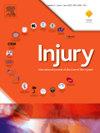塞浦路斯拉纳卡综合医院创伤骨科手术中术中透视的典型剂量值:五年回顾性研究。
IF 2.2
3区 医学
Q3 CRITICAL CARE MEDICINE
Injury-International Journal of the Care of the Injured
Pub Date : 2025-02-01
DOI:10.1016/j.injury.2024.112089
引用次数: 0
摘要
本研究的目的是建立拉纳卡总医院骨科手术室的典型剂量值。采用三种移动c型臂系统,收集了821例5年内接受普通和可重复性创伤手术的患者的克尔玛面积积(KAP)、透视时间(FT)和累积空气-克尔玛(Ka,r)测量值;两架配有图像增强器,一架配有平板探测器。使用定制软件从PACS存档的辐射剂量结构化报告或DICOM元数据文件中自动提取剂量指数。手术根据解剖区域进行分类,包括足/踝关节、胫骨/腓骨、膝关节(股骨远端、胫骨平台)、股骨/粗隆、髋关节、手部、桡骨/尺骨、肘关节和肱骨。将KAP、FT和Ka、r的中位数定义为典型剂量值。c臂系统或涉及股骨/髋关节、胫骨/腓骨和肱骨的不同手术的剂量值变化作为次要结局进行分析。上肢手术的典型剂量值范围为KAP 20.1-197 mGycm2, FT 4.50-14.5 s, Ka,r 0.07-0.71 mGy,而下肢手术的典型剂量值范围为KAP 46.6-202 mGycm2, FT 4.86-24.0 s, Ka,r 0.16-0.74 mGy。动态髋螺钉(889 mGycm2, 14.3 s, 3.10 mGy)和股骨/粗隆髓内钉(长/短钉:2007/1326 mGycm2, 52.3/36.0 s, 6.53/4.05 mGy)的数值最大。使用平板系统的手术中,KAP、Ka、r的中位值下降了65%,74%,FT的中位值增加了119%(膝关节除外)。此外,在比较外科手术时,分别只有股骨/粗隆长/短和胫骨髓内钉与动力髋螺钉和锁定钢板固定相比,显示出KAP、FT和Ka、r值的中位数显著增加。报告的典型剂量值可作为LGH骨科创伤手术中适当的术中透视水平的指南,并在缺乏国家参考剂量的情况下,通过为地方实践审计提供基线,鼓励进一步优化。这些价值也有助于建立第一个国家骨科创伤外科DRLs。本文章由计算机程序翻译,如有差异,请以英文原文为准。
Typical dose values for intra-operative fluoroscopy during orthopaedic trauma surgery at Larnaca general hospital in cyprus: A five-year retrospective study
The purpose of this study was to establish typical dose values at orthopaedic operating rooms of the Larnaca General Hospital (LGH). Kerma area product (KAP), fluoroscopy time (FT) and cumulative air-kerma (Ka,r) measurements were collected for 821 patients who underwent common and reproducible trauma surgery over a five-year period, with three mobile C-arm systems; two equipped with an image-intensifier and one with a flat-panel detector. Dose indices were automatically extracted from radiation dose structured reports or DICOM meta-data files archived in the PACS, using custom-made software. The procedures were categorised based on the anatomical area and included foot/ankle, tibia/fibula, knee (distal femur, tibia plateau), femur/trochanter, hip, hand, radius/ulna, elbow, and humerus. The medians of KAP, FT and Ka,r were defined as typical dose values. Variations in dose values among the C-arm systems or different surgical operations involving femur/hip, tibia/fibula, and humerus were analysed as secondary outcomes. For the procedures on upper extremities, the typical dose values ranged between 20.1–197 mGycm2 for KAP, 4.50–14.5 s for FT and 0.07–0.71 mGy for Ka,r, whilst for the procedures on lower extremities ranged between 46.6–202 mGycm2 for KAP, 4.86–24.0 s for FT and 0.16–0.74 mGy for Ka,r. The largest values were reported for dynamic hip screw (889 mGycm2, 14.3 s, 3.10 mGy), and femur/trochanter intramedullary (long/short nail: 2007/1326 mGycm2, 52.3/36.0 s, 6.53/4.05 mGy) nailing, respectively. A decrease of up to 65 %, and 74 % was found in median KAP, and Ka,r, and an increase of up to 119 % (except knee's) in median FT values for the procedures performed with the flat-panel systems. Additionally, when comparing surgical operations, only femur/trochanter long/short and tibia intramedullary nailing demonstrated a significant increase in median KAP, FT and Ka,r values compared to dynamic hip screw and fixation with a locking plate, respectively. The typical dose values reported could be used as a guide to appropriate levels of intra-operative fluoroscopy in orthopaedic trauma surgery at LGH, and to encourage further optimisation by providing a baseline for audit of local practice in the absence of national reference doses. These values could also contribute to the establishment of the first national DRLs for orthopaedic trauma surgery.
求助全文
通过发布文献求助,成功后即可免费获取论文全文。
去求助
来源期刊
CiteScore
4.00
自引率
8.00%
发文量
699
审稿时长
96 days
期刊介绍:
Injury was founded in 1969 and is an international journal dealing with all aspects of trauma care and accident surgery. Our primary aim is to facilitate the exchange of ideas, techniques and information among all members of the trauma team.

 求助内容:
求助内容: 应助结果提醒方式:
应助结果提醒方式:


